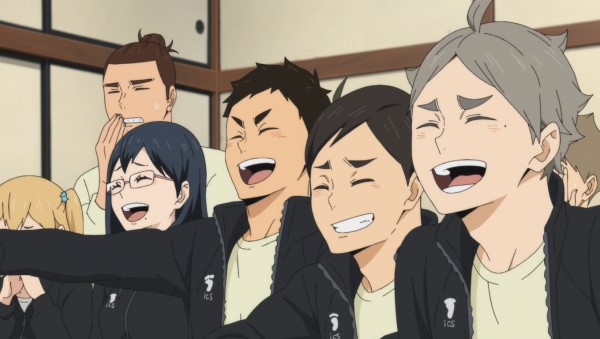 “I’m totally different than the perfect picture I had in my head. Like, some stuff happens and then more stuff, and that ends up being who I am. You don’t have to go hurrying to find anything.”
“I’m totally different than the perfect picture I had in my head. Like, some stuff happens and then more stuff, and that ends up being who I am. You don’t have to go hurrying to find anything.”
Creative Staff:
Story & Art: Asano Inio
Translation: Jocelyn Allen
Production: Risa Cho, Nicole Dochych
What They Say:
From the Eisner Award-nominated Inio Asano, creator of Solanin and Nijigahara Holograph, comes one of his most challenging works yet; an intense teen romance set in what may at first glance be one of the sleepiest places in Japan.
When Koume and Keisuke’s relationship begins to take shape, it is apparent that they are both searching for something. Maybe Keisuke wants something more than a kiss from the fair Koume. Maybe Koume is looking for someone better than Misaki, the local playboy. But what they find in each other over the course of a summer might be far greater than anything they were expecting.
Their lives are going to change. And this will all transpire before high school exams!
The Review:
Technical:
Between Viz releasing Solanin and What a Wonderful World! in 2008 and 2009, plus Fantagraphics releasing Nijigahara Holograph in 2014, Asano Inio’s works are far from new for English-speaking audiences. That said, certain bars for quality of said releases have been set—Viz’s releases having some high-quality card stock-type covers, while Fantagraphics’ was a full-on hardcover. With those releases in mind, Vertical’s treatment of A Girl on the Shore leaves something to be desired.
In terms of packaging, the book is wrapped in plastic (as is standard of all comics with an 18+ rating), and its cover is a thin softcover material that feels like a standard manga volume thickness minus the sheen. Having to remove the plastic wrapping from a softcover book has already resulted in some minor wear that could have easily been avoided had the cover been slightly sturdier. The front and back cover are taken from the manga itself, with the backside having a brief description that feels a bit misleading—Never mind referring to Isobe as “Keisuke” even though he rarely goes by that in the manga, but the last bit about all the events “transpir[ing] before high school exams!” treats the story with a lack of seriousness that it deserves.
The table of contents are the sole color pages, containing artwork similar to the front cover. Besides that, however, it’s a pretty bare-bones release, containing nothing in terms of “bonus content” or frills. At the least, I would have expected an author’s note, or even some ads for other titles from Vertical, so to see nothing but a copyright page after finishing the story did feel like something of a letdown.
Translation in terms of signs and sound effects are inconsistent to say the least. SFX within speech bubbles have been replaced with a proper English equivalent, while SFX without a speech bubble have a translation shown nearby. Signs throughout the book seem to be translated at random, with some having been replaced by English translations, and others being left untranslated altogether. Furthermore, only a handful of the cultural and pop references were given a proper liner note, making a good chunk of the random chitchat characters have feel more foreign than they should have been.
Dialogue throughout the book feels somewhat muddled. While that may be partially due to the characters being in middle school, so their speech patterns are somewhat unique (I’ve noticed Isobe on occasion randomly ending his sentences in a question mark, as if done in lethargy), I doubt that to be the case on all occasions. It’s a minor gripe, yes, but enough of one to interrupt my reading to try and figure out if I missed a line of dialogue or not.
Content: (please note that content portions of a review may contain spoilers)
A Girl on the Shore tells the story of emotionally broken people and their journey to become slightly less emotionally broken. So par for the Asano Inio course, but still much appreciated.
You’re introduced to Koume and Isobe—two students in their last year of middle school. Isobe has recently confessed his love to Koume, but Koume is still having second thoughts, having recently been taken advantage of by upperclassman Misaki. Still, in need of something to cling onto, Koume latches onto Isobe and the two enter an agreement of sorts—the two having sex whenever the other requests it.
On paper, you would think this is the premise of a hentai (or at the least a grungy shojo), but know that what separates it from those is the fact that their having sex is less of a primary focus, and more of a means to measure where the characters are emotionally, which changes throughout the story’s run. Author Inio doesn’t turn away from making their sex scenes any less graphic, and the scenes only ramp up in raunchiness the further into the book you get, but it’s all clearly done intentionally, reflecting the change in how Koume and Isobe see each other, and whether or not that should be considered a good thing or bad thing at the end of the day.
Isobe is something of a social outcast, and Koume is your standard definition of a middle school girl that hangs out with her small group of gal pals. The two have very specific outward appearances to maintain, and yet are willing to come together behind closed doors out of loneliness. The two never kiss, or even hold hands when they’re alone—it’s simply sex with absolutely no strings attached since they know the other is equally broken and won’t do anything to compromise their secret.
Outside of school, the story mainly bounces between Koume and Isobe’s houses, both of which serve as good extensions of their personalities and better demonstrate their similarities and differences. Koume maintains her good-girl persona while at home, and it especially shows in her room, consisting of mainly stuffed animals. But despite being surrounded by friends and family, her interaction with Misaki has clearly left her with a feeling of no longer being able to return to the life she once lived. Koume, on the other hand, is left alone all day, with no students ever interacting with him at school, and his parents always working late. His room is filled to the brim with videogames and manga, and he spends most of his free time online. He is alone by choice, and yet he clearly isn’t thriving off of it by any means. It’s these two differing brands of loneliness that continue to bring the two together throughout the story, even though they may not necessarily even like each other.
The plot is interesting in that you never feel like you’re reading a story. They’re not even vignettes, really. Rather, you’re merely witnessing the daily lives of two middle schoolers—random chitchat about favorite bands and comedians, upcoming school events and entrance exams—it’s all a mishmash of conversations that don’t really amount to much of anything alone, but somehow end up forming a solid narrative that you only become aware of by the end of the story. Koume and Isobe’s repeated “visitations” with each other slowly serve as a means of getting to know the other better, and upon the story’s completion, they each have not only formed trajectories of where they wish to be, but follow up on that trajectory for better or worse. It’s the kind of story I’ve come to expect from Asano Inio, but it’s done well enough and stands out from his other works to the point that I don’t mind.
In Summary:
A Girl on the Shore is an emotional ride about emotionally broken children. Asano Inio’s art delivers beautiful visuals to accompany his unorthodox-yet-still-satisfactory tale about two lonely middle schoolers and how they learn to deal with that overwhelming feeling in blissfully ignorant world.
Content Grade: A
Art Grade: A+
Packaging Grade: B-
Text/Translation Grade: B-
Age Rating: 18+
Released By: Vertical Comics
Release Date: January 19, 2016
MSRP: $18.95



